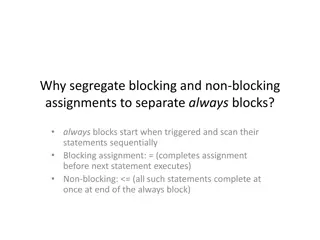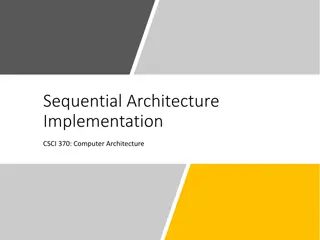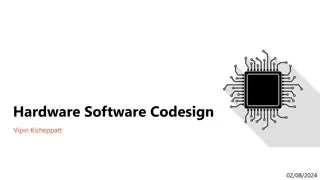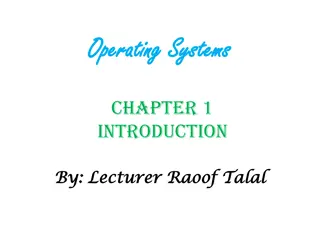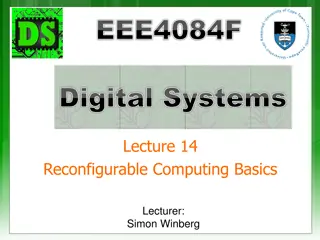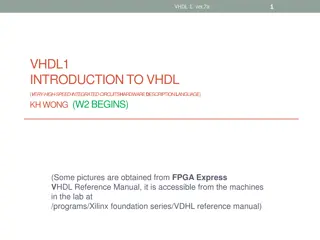Introduction to Verilog Hardware Description Language
An overview of Verilog, a Hardware Description Language used to describe hardware components. It covers the basic concepts, syntax, and modular implementation of circuit components, highlighting the differences from traditional programming languages. The content discusses the use of HDL for circuit behavior description, testing, and verification through simulation. It also touches on Verilog's modular structure, levels of abstraction, and key syntax rules.
Download Presentation

Please find below an Image/Link to download the presentation.
The content on the website is provided AS IS for your information and personal use only. It may not be sold, licensed, or shared on other websites without obtaining consent from the author.If you encounter any issues during the download, it is possible that the publisher has removed the file from their server.
You are allowed to download the files provided on this website for personal or commercial use, subject to the condition that they are used lawfully. All files are the property of their respective owners.
The content on the website is provided AS IS for your information and personal use only. It may not be sold, licensed, or shared on other websites without obtaining consent from the author.
E N D
Presentation Transcript
University of Maryland Baltimore County Department of Computer Science and Electrical Engineering CMPE 212 Laboratory (Discussion 1) Shankar Sharma ssharma5@umbc.edu Christopher Slaughter cslaugh1@umbc.edu * Most of the slides are courtesy of previous TAs: Rashidul Islam and Patrick Sykes
CMPE 212 Discussion Format Lab Grade Full Correct Completion 100% Did you complete the lab correctly? Partial Correctness and Full Completion 50% Did you complete the lab incorrectly? Incomplete Attempts will Receive NO CREDIT. CMPE 212 Introduction to Verilog 2
An Introduction to Verilog Hardware Description Language (HDL) Basic idea is a programming language to describe hardware Initial purpose was to allow abstract design and simulation Design could be verified then implemented in hardware Now Synthesis tools allow direct implementation from HDL code. Large improvement in designer productivity CMPE 212 Introduction to Verilog 3
What is Verilog? A hardware description language (HDL) to describe: Wires o Registers o Connection to Registers o Clock Pulses o Verilog is NOT an object oriented language Verilog uses modules instead of functions and methods CMPE 212 Introduction to Verilog 4
What is Verilog? Verilog is a Hardware Description Language. Syntax is similar to C. Modular implementation of circuit components: Modules form the building blocks of circuit components. Bigger modules are made up of smaller modules. 2 different ways to program ( Levels of Abstraction ): Behavioral Structural more on these later CMPE 212 Introduction to Verilog 5
Hardware Description Language HDL: Programming language used to describe the behavior of an electronic circuit. Uses simulationsto test and verify a circuit s functionality. Difference between HDL s and other programming languages: HDL s include a notion of time. CMPE 212 Introduction to Verilog 6
Syntax White spaces are ignored. Commenting: // single line /* multiple line */ Variables: Must start with an alphabet char, or an underscore followed by an alphabet char. Case sensitive. CMPE 212 Introduction to Verilog 7
Keyword: logic Use -g2012 when compiling and make sure the version of iverilog you install works for this code: module test; logic a; assign a=1; initial begin #0 $display(a); end endmodule // test iverilog -g2012 test.sv ./a.out 1 CMPE 212 Introduction to Verilog 8
Keywords: input and output Input Understood as a special logic that brings input values into a module. Can be read from, unlike normal wires. input [7:0] in1; Output Understood as a special logic that drives output values from a module. Even though it is a wire by default, it can be assigned like a register under certain circumstances. output [7:0] out1; CMPE 212 Introduction to Verilog 9
Modules Most basic unit of hierarchy in Verilog Can be a single circuit element, or a collection of lower level modules connected together. Contained in 1 Verilog file. Multiple modules can reside in 1 file, but this is not recommended. Module name should match the file name. So the module adder would reside in the file named adder.v . CMPE 212 Introduction to Verilog 10
Modules continued Defining a module: module<module_name>(<module_terminal_list>); ... <module internals> ... endmodule Defining a Half Adder module: module HalfAdder(A, B, S, Cout); ... <functionality of Half-Adder> ... endmodule We can describe the functionality of a module with either Structural code or Behavioral code. CMPE 212 Introduction to Verilog 11
2 Levels of Abstraction Structural code Represents circuit components. Behavioral code No direct mapping to circuit components. Gates Loops Lower level modules if-else statements May use Verilog s Gate Primitives: May use Verilog s Boolean operators: assign y = a && b; and u1(y, a, b); Performs the AND operator on a and b, and assigns the result to y. Instantiates an AND gate called u1 with inputs a and b, and output y. CMPE 212 Introduction to Verilog 12
2 Levels of Abstraction Structural: Gate Primitives Behavioral: Operators Predefined in Verilog. Can have multiple inputs. Bitwise: ~, &, |, ^ Logical: !, &&, || Reduction: &, |, ^ and and_1 (out, in0, in1); Arithmetic: +, -,*, /, ** nand nand_1 (out, in0, in1,in2); Relational: >, >=, ==, != or or_1 (out, in0, in1); nor nor_1 (out, in0, in1, in2, in3); Shift: >>, << xor xor_1 (out, in0, in1, in2); 13 xnor xnor_1 (out, in0, in1);
Module Example Structural module sean(O,A,B,C); input A,B,C; output O; logic W; or (W,B,C); and (O,A,W); endmodule CMPE 212 Introduction to Verilog 14
Module Example Behavioral module fred(O,A,B,C); input A,B,C; output O; logic W; assign W = B | C; assign O = A & W; endmodule CMPE 212 Introduction to Verilog 15
Testbench A testbench tests the functionality of a module. Always contains behavioral code. Controls the inputs to a module, and examines the outputs of a module. A testbench for the Fred module: Instantiates a Fred module, and gives this instance a name. 1. Applies all the different possible combinations of A, B, and C to the module s inputs. 2. Displays the output values so that you can see if the Fred module is working as expected. 3. CMPE 212 Introduction to Verilog 16
Module Example Test Bench module testbench4Fred(); logic [2:0] switches; logic y; fred f1(y,switches[2], switches[1], switches[0]); initial begin switches = 000; $display( switches=ABC\n ); #80 $finish; end always begin switches = switches + 001; #10 $display( switches=%b, y=%b , switches, y); end 17 endmodule
How to Compile / Run Verilog files Log onto a computer with linux. In a command window, enter: verilog <testbench name> <module name> Make sure you are in the same folder as the files which you wish to run. If you re not in the same folder, specify the file paths in front of the testbench name and module name. You can append as many modules to this command as you wish, but use one testbench at a time. CMPE 212 Introduction to Verilog 18
Remote Linux Access For windows, download putty http://the.earth.li/~sgtatham/putty/latest/x86/putty.exe Open the exe (don t need to install). The Host Name is gl.umbc.edu and the Connection type is SSH. Enter your UMBC username and password. For Mac/Linux users, open terminal and type ssh gl.umbc.edu . Enter your UMBC username and password. CMPE 212 Introduction to Verilog 19
Some Useful Linux Command ls clear cd <directory name> cd .. mkdir <directory name> // Create a New Folder find // Search for files matching certain patterns cat> <file_name.filetype> // Create new file e.g. cat>half_adder.v cat <file_name.filetype> // To see output of files //List contents of current directory //Clear the screen // Takes you out from current folder // Navigations between folders Always search in Google Use Tab button of keyboard Editor: nano, emacs CMPE 212 Introduction to Verilog 20
Half Adder Module in Verilog & Verification Combinational arithmetic circuit that adds two numbers Output: a sum bit (S) and a carry bit (C) Disadvantage: Only add two input bits and neglect carry Binary addition process is not complete and that s why it is called half adder CMPE 212 Introduction to Verilog 21
Half Adder Module in Verilog & Verification AND Gate X Y Z 0 0 0 0 1 0 1 0 0 1 1 1 X Z Y Z = X & Y CMPE 212 Introduction to Verilog 22
Half Adder Module in Verilog & Verification Exclusive OR (XOR) Gate X Y Z X Y Z 0 0 0 0 1 1 1 0 1 1 1 0 Z = X ^ Y CMPE 212 Introduction to Verilog 23
Verilog Guides Free online tutorial: http://www.ece.umd.edu/class/enee359a.S2008/verilo g_tutorial.pdf Verilog Quick reference: http://www.stanford.edu/class/ee183/handouts_win20 03/VerilogQuickRef.pdf CMPE 212L Principles of Digital Design Laboratory Fall2011 24
Reminder !!! Send your group (maximum 2 persons per group) info to- ssharma5@umbc.edu Name and email address of each member One email from each group The concept of lab groups is of use in in-lab experiments. As of this moment all Verilog assignments are individual. CMPE 212 Introduction to Verilog 25






